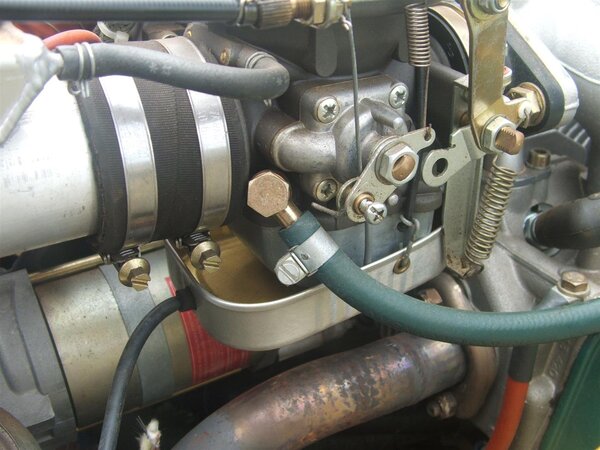-
Posts
724 -
Joined
-
Last visited
-
Days Won
22
Content Type
Profiles
Forums
Gallery
Downloads
Blogs
Events
Store
Aircraft
Resources
Tutorials
Articles
Classifieds
Movies
Books
Community Map
Quizzes
Posts posted by JG3
-
-
What sort of aircraft is that with a 22:1 glide ratio?? That's darn near a glider..... Nothing like most of the recreational aircraft we fly, with GR around 10:1.....
-
 1
1
-
-
I must emphasize that this only tested glide at idle power vs prop stopped, no other option with a Rotax engine.
It says nothing about glide with a windmilling prop.
Someone with an aircraft/engine combo that does leave the prop windmilling at best glide speed needs to do the tests to settle that argument that goes on and on.
It's easy to do, and only needs a stopwatch besides the altimeter you already have, and a phone does that.
Early morning before thermal activity, climb to 3200ft, set up a glide at your best glide speed, time the descent from 3000 to 2000ft. Repeat several times at idle and at windmilling. Average the measured times.
If the prop will stop when pulling up to a slower speed and then stay stopped at glide speed then that would make a really good comparison.
To calculate descent rate - 60,000 / time(sec). To calculate glide ratio - 101.3 x speed(kts) / descent rate(fpm).
Of course do it with an instructor on board and over a suitable runway in case the engine won't restart.....
-
 1
1
-
-
There’s been a bit of discussion (argument) recently regarding the difference between glide ratios at idle power vs with prop stopped. I’ve long known from experience that the glide ratio with prop stopped is less than at idle, but decided to do real measurement tests to settle the argument.
With a Rotax engine there’s no option to keep the prop spinning; it’ll stop and stay stopped very quickly after switching off at glide speed. In an 80kt dive the prop will creep slowly from one compression stroke to the next, but no way spin.
In this test, the idle speed static on the ground was 1670rpm, at 50kts glide speed it was 2350rpm.All tests done by timing with stopwatch the descent from 3000 to 2000 QNH, early early morning before any thermal activity. Three attempts at idle and three at prop stopped, with the average used for calculations. Just watching a VSI is not nearly accurate enough for this exercise.
For the Savannah, 50kts is the speed for best glide ratio, as determined by earlier testing.
Times recorded for these tests are - at idle 101 seconds, at prop stopped 94 seconds.At idle - 101sec/1000ft = 594fpm descent rate = 8.5:1 glide ratio @ 50kts.
Prop stopped - 94sec/1000ft = 634fpm descent rate = 7.9:1 glide ratio @ 50kts.So for each 1000 feet of descent, the aircraft will glide 8,500ft at idle or 7,900ft with prop stopped. So that’s 600ft (182m) less distance at prop stopped than at idle.
That may not seem like much until you’re on a final with prop stopped and find that you’re falling short of you’re aiming point….. So need to aim farther from the intended touchdown point to allow for that difference. Quite a bit farther in practice, and then slip off height to hit the chosen point.
That’s if you’re practiced at idle power approach already, rather than using some power to maintain a glide slope. If you’re using power regularly then you aren’t at all prepared for a deadstick landing…. I always pull power to idle at the start of base leg and don’t change that right to touchdown – good practice. I only need to change that when someone ahead is tying up the circuit with a long powered final….
I’ve done dozens of prop-stopped landings and really value the experience and the confidence that builds. I realize that we’re supposed to only do that with an instructor on board, but I know from early training what cautions are required and follow those lessons carefully. I reckon everyone should get that experience. A convenient way to do that would be when you next do a BFR to ask the instructor to let you do a couple of dead stick landings – you could learn a lot.….. If at first you can’t hit your chosen spot then do it again and again until you know how the picture should look on approach.
But one tip: As soon as the prop fully stops after switch-off, throw the switches back ON to be ready for a re-start. If you don’t, you’re liable to get a heart attack when you need power again and crank the engine and it doesn’t start right away…..
-
 3
3
-
 2
2
-
 1
1
-
-
Yes still watching. Want to hear the result of this mystery.....
-
Bombardier Recreational Products (BRP) says it has suspended the delivery of aircraft engines to "countries with unclear usage" in the wake of reports that some of those engines are being used on Turkish combat drones deployed by Azerbaijan in fighting against Armenian forces in Nagorno-Karabakh.
The Quebec-based company — better known for its Ski-Doo and Lynx snowmobiles — said it became aware late last week that some of the recreational aircraft engines produced by its Austrian subsidiary, Rotax, are being used on Turkish Bayraktar TB2 unmanned aerial vehicles (UAVs).
https://www.cbc.ca/news/politics/turkey-armenia-azerbaijan-drones-bombardier-1.5775350
-
Gday,
Finally the results of testing the EProp in comparison to Bolly and Kool (Luga), using manifold pressure to set engine power exactly equal for each.
Once again surprising results that required testing again and again to confirm.
The results and analysis are several pages so access them here
https://www.stolspeed.com/nid/46-
 2
2
-
 3
3
-
-
Synthetic clothing is the greatest static-producer you can get, Watch these people set their cars alight by jumping in and out of the seat whilst refuelling (videos follow on).
She was very cool the way she handled that flareup.
-
 1
1
-
-
Just heard from a friend there was a accident at Gatton airpark this morning with a trike....apparently on landing. Hope it isnt who I was told
It's not who you were told. I have word from a neighbor of his at Gatton Airpark. He flew a trike there.
-
JG's ( JG3 this forum ) website Stolspeed has a Map of available fuel
StolSpeed Aerodynamics - Performance Enhancement for Light Aircraft
That's way out of date; I haven't kept it up. There's way more available now as already demonstrated. Excellent project. Hopefully tied in with OzRunways for convenience.
-
And these days the USA can't produce enough face masks when they need them......
-
 1
1
-
 2
2
-
-
You will find a drop down menu and select CLOSED.
I've done that but the ad is still up......
-
Now my question is how do I remove an ad after the item has been sold??
I guess I'm slow but can't find a way to do it.....
-
I found that these sardine tins do the job very well. Fit snugly around the float bowl. Held up by either light bungy cord or tie wire. Drain tube is plastic drip irrigation line forced into slightly undersize hole. Been using them for 10 years no problems. Light weight and the price is right..... I particularly like their heat shield function from the hot exhaust right below.
-
 4
4
-
 1
1
-
 1
1
-
-
JG chipping in here......
Those ICP VGs should just click into the holes provided, in that paired pattern as you see in the photo.
If you didn't have ICP VGs then the Stolspeed VGs will just stick on over those holes in the same pattern.
ICP purchased their very first set of VGs from me at Narromine. At the time I was importing the VGs from the USA, and ICP copied that style of VG. I never liked that style with the sharp point and the crude base, so I later designed my own.
ICP chose to go with the paired pattern that some other suppliers used. I tested both that paired pattern and the alternating angles pattern that I now use. I preferred the alternating because I found that the paired pattern caused the vortexes formed to interfere with each other and tend to rise from the airfoil, while the single VGs in alternating pattern gave tighter vortexes that tend to stay tight to the airfoil where they should be for best effect and least drag. Either method will work on the Savannah, which already has a very forgiving airfoil.
-
 1
1
-
-
<<do you listen to area frequency to stay safe and informed? >>
Informed about what the big jets and IFR aircraft are doing way up there, but nothing about the low level VFR you may encounter....
-
Thank you. I didn't realize that you need to select the category first step. Done now.
-
 1
1
-
-
How do I add a new posting in the classifieds?? Maybe I'm blind but I can't find a way in.....
-
I used an adjustable circle cutter similar to this. General Tools 55 Heavy Duty Circle Cutter. Adjustable 1-3/4 Inch to 7-7/8 Inch: Amazon.com.au: Home Improvement
Not too expensive and did a good job, but use a solid bench drill, clamp the panel securely and keep your fingers and anything else you value well out of the way.
Work the circle cutter by hand. Round and round a few times, from both sides of the panel. Done it many times, safer than a powered drill.....
-
 1
1
-
 2
2
-
-
I watched a country show when they emptied all the oil from an old Vanguard and then took bets as how long it would last. It drove around and around the race track while the evening show, complete with fireworks, took all evening, but the Vanguard was still going well.... Finally it was getting late and everyone wanted to go home but the engine giving no sign of seizing. Finally they drained the radiator and then it only lasted another half hour....
-
 2
2
-
-
Hi JG3: do you happen to remember if the aircraft used in the STOL competition was a Savannah classic -with slats-, a Savannah VG, a Savannah XL or a Savannah S?
It's a VG.
-
Boy, it sure doesn't take you guys long to run a thread off topic into BS jousting......
Please set up different threads for that game so that the rest of us can avoid it all......
-
 3
3
-
-
I cannot recall seeing any Sav without the jury struts.
There were no jury struts before the 560kg upgrade.
-
There's some video on Facebook. Looks like he managed to hit one of the only thick scrub patches in the midst of cane fields and paddocks all round...... Right next to a big power line as well.....
-
 1
1
-
-




Prop stopped.
in Student Pilot & Further Learning
Posted
Try it, you might like it. It's a delightful feeling just floating along with just the swish of the air going by. It's almost addictive..... Focus on the airspeed for best glide and the plane will fly just fine.